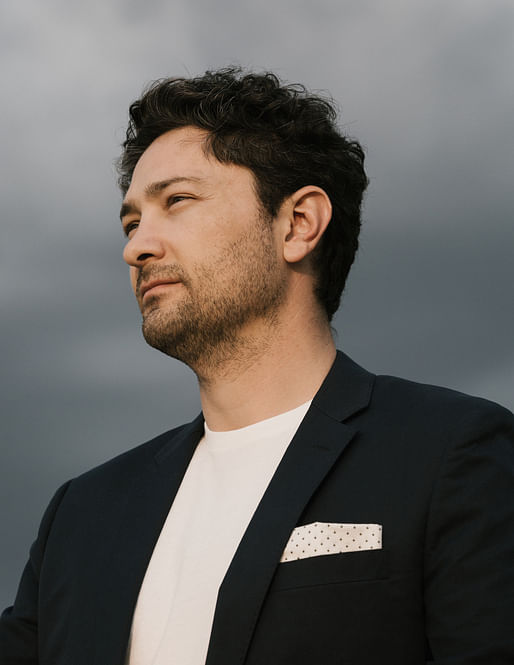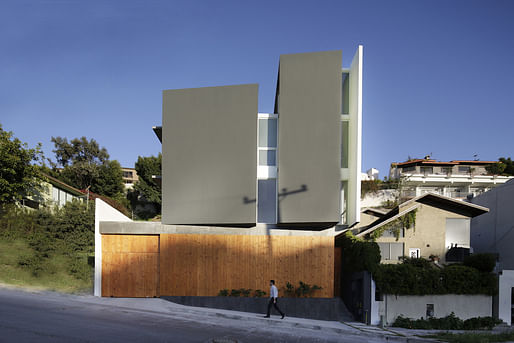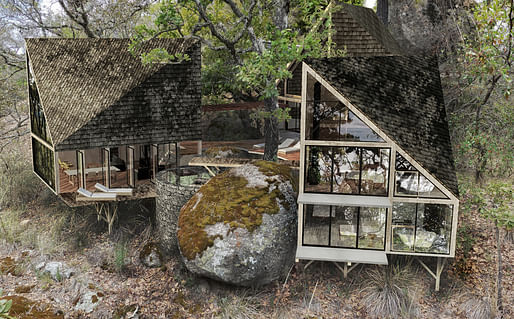

Alfonso Medina is the award-winning founder of T38 an architecture and development firm based in New York City and Tijuana, Mexico. At only 32 years old he has built up his firm over the past 10 years focusing on the intersections of residential housing, urban planning and community development. Medina recently spent some time with Modelo to reflect upon the last decade, the evolution of his approach to design and the future of architecture. Full interview below.
On becoming an architect and starting a firm
I’m 32 right now but started 10 years ago this summer. I’d been studying in Monterey, which is in the northern part of Mexico close to Texas where I was actually born. I had the opportunity to study abroad in Barcelona and it was amazing, really fun. That’s where I really got to see what architecture really was about, because in Mexico, where I grew up, architecture was really related to construction and development, but in Europe I saw another side of architecture that I hadn’t gotten to see in Mexico. That’s when I really fell in love with architecture.
I came back to study in Monterey and was really disappointed seeing the difference from where I had been studying abroad to my home school and got kind of bored. My parents were living in Tijuana at that moment and they said “We have a plot of land and some friends want to buy a house in that neighborhood, why don’t you build it and sell it to them.” That is Mexico, everything is easier, so I said “sure why not?”
I dropped out of school, moved to Tijuana and started building this house. I drew up probably ten drawings just two plans, two sections, two elevations. Got to the site, hired local construction workers and that was it! I spent one year with them there on site building this house. There were only ten plans so all the decisions were made on site and I learned how to build with these guys who were experts in construction and knew more about construction than most architects. I spent a year full-time with them hands-on learning how everything is built. That was an amazing experience. After that I had already put together this team, spent a year with them, enjoyed it a lot, but I had to go back to school, it was a 2.5 hour flight so it wasn’t that close. But I said I already have this we should keep going. From there, bought another two plots and kept on building houses. It was more like spec housing. So I went back to school and would fly back every other weekend just to spend time on the sites.

“Obreros” T38's construction team in Tijuana, Mexico (Photography by Pablo Casals-Aguirre courtesy of T38)
On the first five years
For the first five years I didn’t design for any client, I didn’t have any architecture clients because I wasn’t even an architect. Obviously nobody would hire me to design something since I hadn’t graduated. I just kept designing and building the projects that I was developing. I had the opportunity then to do an internship in Chile and it was funny because I was doing this internship for this super famous architect in Chile but I was working on so many projects back in Tijuana, I was 23. I would fly back from Santiago, Chile and take a direct flight to LA once a month for a weekend, and this was an 11-hour flight. I had to go back to see how everything was going. I was selling these houses to people who were double my age so at first it was a little bit hard for them to believe I could actually deliver but it was a pretty straight-forward process.
Having this construction crew that was full of experts and my dad was an architect too so he helped me a lot, and my mom would be the construction manager. That just kept going and after a while, I wanted to see what the next step could be. I was developing this eighteen house complex, so we were really working on a larger scale of the city in a sense. Tijuana is an interesting city: it’s on the border between the United States and Mexico, everyone has heard about it, mostly because of it’s bad news a couple of years ago. Those years were the years it was super dangerous. I started realizing the power architecture has to shape lives, especially in a situation like that, where everybody that could, was moving to San Diego and abandoning the city because there was absolutely no quality of life. They couldn’t go out to the street, restaurants were closed, the city was really suffering. At that moment that I was thinking “what’s next?” I started a master’s program at SCI-ARC in LA and had my mentor there, the director of the program, Peter Zellner who’s an amazing architect and thinker. That really shaped my way of thinking in what the potential of what I was doing was. I was seeing it at that moment as a house or ten houses or eighteen houses but after doing this urbanism program it really changed and shifted the way of the practice of what we were doing and what our aim was.
On the significance of the Machiavelli quote on T38's website
“The best good you can do is the one you do to your own city.” I mean this is a really controversial thinker, but it’s 100% true. It’s really easy and not that complex. You can design an amazing bench and that bench will have a very positive effect on its context. It depends on the scale and magnitude of what you’re doing, but whatever you do… I mean sometimes architects don’t think much about it but we have a huge responsibility because whatever we do has a huge impact on a lot of people for a long time. It’s not like you’re designing a product that could be discarded. We have this responsibility and this gift to shape people’s lives, to really shape a city and to have an amazing impact on the future of the society that we’re working in.

“Aria” Tijuana, Mexico (Photograph by Pablo Casals-Aguirre courtesy of T38)
On T38's current approach
All of our development projects are residential, mostly mid to high-end residential. We’re interested in doing low-income housing but as a business model in Mexico it is really hard to develop because most low-income housing was developed by huge corporations. They only cared about their stock price so whatever they did or didn’t do within their housing models was just to reflect their stock prices. These guys designed “cities” that were two hours away from any job source. They were selling them super cheap. You could buy a house for $5 down, you obviously are paying for it for the rest of your life, but just to acquire one was super easy. Everybody bought a house and after a while they would notice they spent half their income on transportation, getting to the city centers. It was a totally unsustainable model and that model just burst two years ago, all of these companies went bankrupt and there is a huge crisis of low-income housing. As a business model it was really difficult to compete with them because they were getting land for nothing. It was basically the only way low income housing was developed for the last fifteen years in Mexico.
Our model was mostly upper/middle class residential development and every project we did we saw as an opportunity. For example the housing complex we did that had 18 houses, we cared more about the street that was in the middle, than the houses themselves. How could you make a development model where all the neighbors will know each other? That was super important for us. We aren’t proud of doing good architecture, that should be implicit in every project, we’re proud of really accomplishing communities for people to live in and having a positive impact in the cities that we are working in. Every project has a different objective. Then we did a townhouse development in a neighborhood that was very upscale in Tijuana and it was all large scale houses. We worked with the city to get permits with the city to do a layover so that instead of doing a single house, we did four townhouses. We worked a lot to convince them and finally managed to do that. Being able to potentialize these shifts in density, the density will finally change, it’ll become more efficient, it’ll even become more affordable. You have a city that is more affordable but instead of buying this huge house you can buy smaller houses that are better located.
Every project was an opportunity for us to develop the city in a different way. As a business, we reached the ceiling of our financial model of what we could as a company to develop. We really wanted to start working in other scales too. That’s when we started working with other clients. For other developers or sometimes just people who had land, who we told, “This is what you can develop there.” For example right now we’re designing three different buildings, one block after the other for three different clients in a neighborhood that had no multi-family built in the past 10 years. We’re really interested in the urban field, it’s not just designing a beautiful building, it’s about the relationship between these buildings and how they will affect the community and the context in a positive manner.

“Arboleda”, Tijuana, Mexico (Courtesy of T38 Studios)
On his design process
We use every available tool. A part of our work is related to contemporary art and we’ve always tried to collaborate with artists and art institutions, we did an art space in LA, we’re doing a cabin for an artist in Guadalajara, an artist studio in London… We’re always involved with this creative process of artists and learning how they create. I mean tools are really important. My practice grew up in a world where craftsmanship was everything and that manual labor of architecture was really important to us. Even a sketch, was super important to our process. You could take a picture with your iPhone, send it to the guy who’s building it, and it would get built in half an hour. But now that we’re working with different cities and countries, software has become a really important tool and what we’re most interested in is the online platforms for sharing, for editing, for collaborating.
On the relationship between teaching and practice
The academic sphere is super important. For me it was very weird going into a place like SCI-ARC, which is super avant-garde. They’re dealing with mostly architecture that will never get built. I was there building all these houses that were very pragmatic in practice. It’s interesting to be in conversation with themes that are so radically different, because there are so many different ways of seeing architecture and reading architecture. For example the first houses that we did, we were trying to do contemporary architecture in this context where contemporary architecture didn’t really exist. People were buying the houses because it was a good and affordable option but they didn’t care about architecture. After having lived in the space and having seen how it worked, they would eventually start talking about architecture.
After I finished at SCI-ARC Peter Zellner the Director invited me over that summer to teach with him. I taught there at the same time I was teaching in Tijuana. So for one year I taught in Tijuana and in LA and then after that I taught for a year as a visiting professor in Paris. It’s super important just to be influenced by everything you can. I always tell students that they shouldn’t read up on architecture, they shouldn’t see architecture books — they should be influenced by other things. You have to be influenced by the world that surrounds you, by contemporary art. You see the way of thinking and doing of a chef, it could influence you way more than an architect’s way of thinking could. That’s what makes it interesting, when people are influenced by all of these different things. It makes a more sensible and complete body of work and way of thinking.
On the future of architecture
I think disruption is happening every day. Just the world we live in, the pace is going so fast. Everything is super connected and online. That has really helped us see the world around us in a different way. For example, David Adjaye doing research in every major capital in Africa. Projects being funded through crowdsourcing initiatives. Latin America in the 1960s, you had amazing social housing projects all over in every major capital.
Architecture is super slow. It’s a profession where projects take so much time to get accomplished that for me that’s why I’ve always tried to look for different ways of working or different models of development, being able to create our own projects. I think that’s part of the future actually. You don’t need a lot of money, you just need ideas. That’s the power that ideas have right now, that you can actually get them built. You just need to have the right tools to get your ideas out there.
 “Last Piedras” (Courtesy of T38)
“Last Piedras” (Courtesy of T38)
On his dream project
There’s so many! I’m a huge fan of Shigeru Ban’s work and what he’s been able to do related to housing after disasters. I think that the projects that can have the biggest impact are the ones within the housing realm because it’s the biggest component in a city. Just being able to design affordable housing. It’s done in different ways, in different countries, and in different contexts, but finding ways in which you can design a house that can actually be self built by someone anywhere. Mexico, Senegal, Finland. The future is more about open source. I don’t understand why so many professions are now working in that manner and architecture is something that is very institutionalized. We have learned so much from having a practice that is based in such contrasting cities as New York City and Tijuana, and moving so much back and forth between them. The pace at which we do projects in Mexico, for example, this 300,000 square foot project that we won a competition for a year ago is already under construction and will be finished in fourteen months. Here in New York, to do a sidewalk it’ll take two years. That contrast for me is amazing and learning about the ways things are done in different contexts seems like a great opportunity. I think architects need to take more risks. We need to learn more from other professions, and be more of entrepreneurs.
On advice he would give to himself before starting
Work for someone else. You learn from mistakes, so it’s always better to make mistakes within an environment in which you can be mentored. I wouldn’t be here if I hadn’t started my practice when I was 22, but definitely I think that just learning from other people would have been a good experience. I have the amazing opportunity of having a team that sometimes is more than one hundred people, between construction workers and architects, so it can be very complicated to have the responsibility over so many people. But at the same time it’s so rewarding to have a team where everyone is proud of what they are doing, in which the input of the carpenter or the mason has the same value as that of the architect. In the end, I think that is what our work reflects.
Design Manifestos delivered weekly
subscribe to our newsletter.
At Modelo we want to know what drives the world’s design and architecture talent. This is why we invite select architects and designers to share their stories, philosophies, visions and favorite works with the public — their manifestos. For more information on how we're working to change the architecture and design world at Modelo please visit us at: www.modelo.io.
No Comments
Block this user
Are you sure you want to block this user and hide all related comments throughout the site?
Archinect
This is your first comment on Archinect. Your comment will be visible once approved.